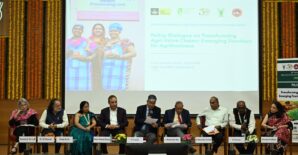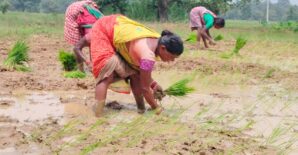Cross-posted from the FSP India website written by Jaspreet Aulakh

Hamish John Appleby / IWMI
Partially spurred by the recent droughts in several states in India, a conference was held in Telangana on October 15, 2015 focusing on “Mitigating Agrarian Distress in Indian Agriculture” as part of a series of dialogues being organized under the Indian Food Security Knowledge Platform and Policy Dialogue. The conference was jointly organized by IFPRI and Centre for Good Governance and took place at the CGG Conference Centre in Andhra Pradesh. Distinguished guests from government, national and international researchers, and private stakeholders participated in the event.
The workshop aimed to look at the problems the agricultural sector faces from the recent drought to formulate proper policies and programs, not only for achieving sustainable and inclusive development of agriculture but also integrated rural development. The main goal of the workshop was to frame a set of recommendations to resolve the agrarian crisis based on an evidence-based assessment of the situation.
Although there are already government policies in place to support irrigation in case of dry spells, including an early weather advisory system and power regulation, there are still many Indian farming communities feeling the impact of drought and entering a phase of agrarian distress. The worst fears of a second consecutive year of rain deficit have played out as 2015 saw the adverse effects of drought in states of Karnataka, Maharashtra, Telangana, Andhra Pradesh, Uttar Pradesh and Bihar. The Indian Meteorological Department (IMD) has reported 12 percent average shortfall covering 40 percent of India for 2015. With a 43 percent below normal deficit in rainfall, Karnataka is the only state to declare drought this year and many districts-- 27 out of 30-- are affected. Yet other states are suffering severely as well; Maharashtra is experiencing a deficit of 51 percent below normal rainfall, for instance.
The central government has released 591.35 million USD as a national relief fund for the state of Karnatakam and last year 617.6 million USD were released for state of Maharashtra. The states of Punjab and Haryana are able to better cope to drought this year due to advanced irrigation facilities than other parts of the country. The delayed rains of September may alleviate some of the further damage but it is unlikely to mitigate the damage already done to agriculture production for 2015. Hence, there is a need to address this agrarian stress which is multi-faceted through government policies.
The specific objectives this conference were the following:
- Assess the socio-economic impact of recent droughts in India,
- Document technological developments to reduce impact of drought.
- Review government policies and programs which mitigate drought impact.
The impacts of droughts are multifaceted. They range from impacts on the quality and quantity of agriculture produce, on resources such as soil and surface water and depletion of productive assets, and on reduced demand for non-agriculture goods and services. Drought can exacerbate poverty, along with other socio-economic phenomena such as outmigration and overcrowding of cities. Drought can also impact prices of agricultural commodities according to one study presented at this workshop. It was also discussed that hot spots for extreme poverty, unrest, and outmigration are drought-prone areas which can cause effects to be exacerbated due to low resilience to shocks.
Coping with drought has been one of the underlying objectives for government of India for widespread public programs such as PDS (Public Distribution System), MNREGA (Mahatma Gandhi National Rural Employment Guarantee Act), and Agricultural Insurance (National Crop Insurance Scheme). Agricultural insurance is not taking off in India despite the sufficient supply because the willingness to pay for insurance is low in India. Thus, there is need for improvement in product design for selling insurance products in India. Insurance is particularly important in drylands as there is high production risk. There needs to be more studies to estimate whether insurance has improved household economy and improved livelihood opportunities. MNREGA which can also be applicable in scenarios of drought has prevented 14 million people from falling into poverty since the start in 2005. Less developed regions which use MNREGA show higher participation and higher rate of poverty reduction than more developed regions.
PDS as a vehicle for food security, is the oldest system designed by government of India and needs to be designed around three elements of ‘Availability’, ‘Acceptability’ and ‘Accessibility’ (3 ‘A’s) and active involvement of other states besides Uttar Pradesh, Punjab, Andhra Pradesh, and Haryana. Food availability is a necessary but not a sufficient condition for food security. The Abhijit Sen Committee (2000-2002) brought out the conundrum of availability of excess food and simultaneously food deprivation/starvation. Therefore, the focus of the policy instruments must be to improve access to food with proactive planning, particularly in areas prone to drought without waiting for manual-based declarations.
Presentations also highlighted the existing drought-proofing methods such as solar pumps, drought-tolerant seeds, cloud seeding, and diesel pumps. Cloud seeding was a new concept which is interesting technology used to seed small clouds to create artificial rain over the drought prone agricultural areas. Drought tolerant seeds is an agronomic intervention in which staple crops are bred for drought resistance (can tolerate dehydration in critical growth stages) and show early maturity helping them to escape dehydration. Solar pumps are another mitigation strategy used by Bihar government helped to bring down the cost of irrigation 266 percent when compared to conventional irrigation methods in the case of wheat.
The Telangana government programs includes several initiatives along with Universities to mitigate drought. The press is highly used in the months of high drought risk to spread the weather forecast of Indian Meteorological Department (IMD). The contingency plan in event of drought explaining the adaptation strategies, climate variability, and possible rainfall deficit is shared via video conferences and the farmers given sowing instructions for rainfed crops. The updated forecast is communicated to the officials of Department of Agriculture, farmers and scientists. Wide coverage of contingency plan is given via national television network and 14 other channels.
Bihar government programs for drought proofing include subsidies on shallow tube wells, diesel pump-sets, and investment in public tube-wells. Affordable irrigation is one of the essential components for creating resilient agriculture in Bihar which depends upon affordable power. The current solar-pump model needs immediate change, with farmers and solar companies requiring a modified financial model.
Some options discussed during the dialogue included-stress mitigation with relief measures and subsidies, reduction of single cash cropping, optimization of state reservoir capacities, crop insurance, and improvement of irrigation conditions, alternative government employment, and accessibility of low-interest institutional loans.
The summary conclusions of the dialogue include the following:
- There is a need for better information sharing on the role of particular departments within the government as well as more coordination in dealing with drought; for example, between those doing remote sensing and those looking at the agricultural markets and production. More discussion is needed on the role of national markets which can reduce the burden of distress by allowing free trade among Indian Agriculture Markets.
- Non-farm employment needs to be considered in policies, as it can be important insurance tool in the incidences of agrarian distress. The non-farm sector has high potential in Telangana and Andhra Pradesh states, for example.
- There are many existing policies such as MNREGA, PDS, and NIAS, demonstrating the government’s active role.However, new policies should be built around and in coordination with the programs in place and formulated in the context of the Indian political economy as.as these programs receive a great amount of funding but are not reaching the desired results on poverty reduction.
- Tweaking already existing programs cannot give a sustained solution for solving the existing issues. Thinking outside the box is needed along with provision of skill-development programs and crop diversification with livestock, for example.
- There is need for pragmatic policies which are based on real-time data and multi-programed technology. Climate-smart agriculture methods are needed as well as a location-specific understanding of the impacts of drought.



